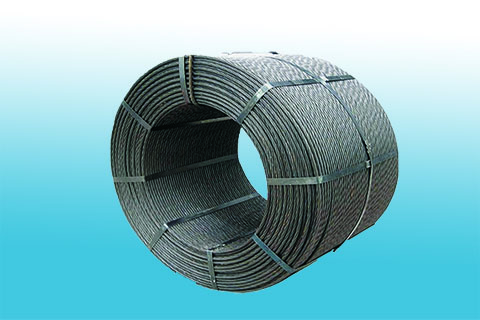
Prestressed steel strands are stranded steel cables composed of 2, 3, 7 or 19 high-strength steel wires, and are subjected to stress relief treatment (stabilization treatment), suitable for prestressed concrete or similar purposes. It is made of high carbon steel wire rod, cold drawn into steel wire after surface treatment, and then a certain number of steel wires are stranded into strands according to the steel strand structure, and then subjected to a stress-relieving and stabilizing process. The main characteristics of prestressed steel strands are high strength and good relaxation properties, and they are straighter when unfolded. Common tensile strength grades are 1720, 1770, and 1860 MPa. The yield strength of this steel is high. The implementation standard: The main implementation standard of my country's prestressed steel strands is: National Standard GB/T 5224-2014.
The main technical parameters
|
Stranded wire structure |
Nominal diameter of steel strand |
Strand strength |
Maximum force of the whole steel strand |
The maximum value of the maximum force of the whole steel strand |
0.2%Yield |
Maximum force total elongation% |
Stress relaxation performance |
|
|
The initial load corresponds to the percentage of the actual maximum force/% |
1000hStress relaxation rate r/% |
|||||||
|
1×7 |
15.24 |
1860 |
260 |
288 |
229 |
3.5 |
70
80 |
2.5
4.5 |
|
17.80 |
355 |
391 |
311 |
|||||
|
18.90 |
409 |
453 |
360 |
|||||
|
21.60 |
530 |
587 |
466 |
|||||
|
1×19S(1+9+9) |
17.80 |
1770 |
368 |
410 |
334 |
|||
|
19.30 |
431 |
481 |
379 |
|||||
|
21.80 |
554 |
617 |
488 |
|||||
|
17.80 |
1860 |
387 |
428 |
341 |
||||
|
19.3 |
454 |
503 |
400 |
|||||
|
21.80 |
583 |
645 |
513 |
|||||
Scope of application
Prestressed steel strands are mainly used in prestressed reinforced concrete for roads and bridges, tunnels and mines, etc., to meet the country's demand for high strength and low relaxation prestressed steel strands for highways, railways, bridges, and dam construction.
User's manual
(1) Before construction, the test piece shall be taken for mechanical property inspection according to the provisions of the current national standard "Steel Strand for Prestressed Concrete" GB/T5224-2014, and its quality must meet the requirements of the relevant standards.
(2) Anchors, clamps and connectors for prestressed tendons should be adopted according to the design requirements, and their performance should meet the requirements of the current national standard "Anchors, clamps and connectors for prestressed tendons" GB/T14370, etc.
(3) The anchors, clamps and connectors for prestressed tendons should be visually inspected before use, and the surface should be free of dirt, rust, mechanical damage and cracks.
(4) Fracture or slippage of prestressed tendons should be avoided during tensioning. When fractures and slippage occur, the specifications must be met. For pretensioned prestressed members, the prestressed tendons that break or slip off before pouring concrete must be replace.
(5) When the construction requires excessive tension, the maximum tensile stress should not exceed the provisions of the current national standard "Code for Design of Concrete Structures" GB50010.